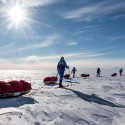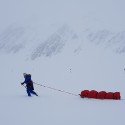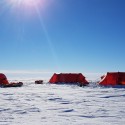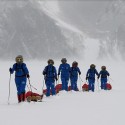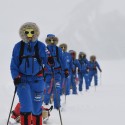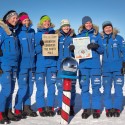Reservist Sophie Montagne, shares her experiences of this ground-breaking expedition across Antarctica, proudly supported by the Ulysses Trust.
As we touched down on the blue ice runway of Union Glacier base camp and the Ilyushin plane’s doors opened, we braced ourselves for that first blast of the Antarctic chill. But it wasn’t the cold, it was the blinding light that shocked me, the fierce, frozen sun that reflected off the ice, the snow and everything it touched. Here we were, after 2 years of training, team selection, dragging a tyre across London for my daily commute and jumping into Swiss crevasses to practice enabling a rescue. The Ice Maidens were finally in Antarctica.
A six-woman team, we were hoping to become the first female team to complete a trans-Antarctic crossing – skiing 1,704km coast-to-coast using muscle power alone. Only 20 people had ever recorded this feat and we were hoping to write the women of the British Army, and especially the Army Reserves, into the record books. The team was led by Maj Nics Wetherill (RAMC) who dreamed up the idea, and she was joined by Maj Nat Taylor (also RAMC and a GP), Capt Zanna Baker (Royal Artillery, attached to DCSU), Lt Jenni Stephenson (32 Reg Royal Artillery) and the two Reservists Maj Sandy Hennis (37 Royal Signals) and myself, LSgt Sophie Montagne, flying the flag for the ranks, the Reserves and for the HAC.
We planned to stay at Union Glacier base camp a couple of days to test kit, acclimatise and then get on our way. Along with Ben Saunders and a Norwegian pair, we were the first expedition teams to arrive in Antarctica, but it turned out we were the last to leave. We had a 6hr Twin Otter flight to our start point on the other side of the continent, but winter was lingering longer than usual and we couldn’t get the weather patterns to match up. So we waited. And waited. The Antarctic summer is just 3 months long and we needed 75 days to complete our Antarctic crossing, so every day spent in base camp was another day lost on the ice.
In the end the Norwegians were offered the first flight slot, but storms pinned them down in their tent for six days – a delay that eventually cost them their expedition. We ended up waiting 15 days in base camp with despair creeping in until, at last, on 19th November we took down our tents, packed up our pulks and set off for the start. At our first refuel point we and the Twin Otter camped overnight to wait for the weather to clear, so it wasn’t until lunchtime on the 20th January that we touched down on the Ross Ice Shelf and took the first steps on our journey. Waving goodbye to the plane, we had that awesome feeling that we were completely on our own, thousands of miles from a living soul and the adventure was about to begin.
We skied 16km that first day, crossing the invisible line from the ice shelf onto land which marked the start of our continental crossing. The weather was a balmy -10C and as we pitched camp for the first time, we were so excited to finally be on our way. And then the storm hit. We woke up the next day to white-out conditions and a furious wind. After a couple of hours the wind was so strong that I could hardly stay on my feet and Nics made the call to pitch tents. The weather report from base camp said “Batten down the hatches, it’s about to get worse”. So there we were, trapped in our tents for two days, and this was when our military training kicked in. The visibility was so bad that we couldn’t see from one tent to the next, so we set up a comms cord to follow. Unlike in a harbour area, if somebody wandered by even a couple of metres they would be lost like Titus Oates. We also set up a stag rota to go out and check the tents every hour to make sure they were properly secured and not getting buried in snow. During the storm the wind reached 100kph which is far more than our polar tents had been tested to, so losing them was potentially life-threatening.
Eventually the storm passed and we were back on our way, but it had been another expensive delay. When we had set off we had just 68 days of Antarctic summer to complete a continental crossing that we expected to take 75 days. Now we’d just lost another two days and were seriously doubting that we’d have time to complete the expedition. As we passed through the mountains we had our first experience of the raging katabatic winds, and started to climb the Leverett Glacier taking us from sea level up to the polar plateau at 3,000m. With full pulks, the altitude, the gradient and the crevasse risk, this was the section we’d all dreaded. The climb was relentless but our extensive training in the mountains of Norway had paid off as it wasn’t as steep as we’d feared. Nevertheless, another hurdle was thrown in our path. Sandy went down with, in her words, “man-flu” – you know, the lethal kind. Devoid of energy it took every ounce of strength to keep moving, but we didn’t have time to stop and let her recover. We took all of the weight out of her pulk and divided it between the rest of us while she fought the mental demons that were telling her to quit. We’d all agreed that it wasn’t about a team getting to the finish, it was about the whole team, every single one of us making it to the end, so there was no way we were going to call in a cas-evac or leave her behind.
After a week Sandy pulled through in an absolute triumph of mental strength, and we trekked on towards the South Pole. Soon we came across a cache left by the climber Leo Houlding – his footprints were the first sign of life we’d seen in 3 weeks which was unfathomably exciting. He said he’d left us a surprise so, digging into the mound of snow, we discovered a bottle of rum and some Green & Blacks chocolate (that man has taste!). We could not have been more grateful for this addition to our previously dry expedition and shared a tot of rum to celebrate crossing each degree line from then onwards.
Finally, on 16th December we arrived at 90 degrees South and, as the temperature hovered in the minus 30s, gathered around the silver globe for the mandatory South Pole photo. Although it was mind-blowing to be standing at the bottom of the earth, I was aware that for most expeditions this is the end of their journey, whereas we were less than one third of the way through. We still had 1,200km to ski, so we picked up our resupply, had a tour of the US Research Station and put on our first set of clean clothes in 26 days!
After the Pole, Christmas and New Year, the days all roll into one long slog of endless days and endless white. The landscape was featureless, the skiing was repetitive and we would ski for a minimum of 10 hours, covering up to 46km per day. I’m not going to lie, it got pretty boring! So this is when we relied on our iPods and a constant stream of Desert Island Discs (Kirsty Young became the 7th Ice Maiden) podcasts, audiobooks and uplifting music. Every day, whether there was sun or a white-out, we pictured the finish – the “Love Actually” moment with our families at the Heathrow Arrivals terminal. Even more than that first shower in 60+ days, it was the moment we looked forward to most.
After our second resupply at Thiel Mountains, we realised we had just 15 days to go and really went for it. We skied for 11hrs and covered more than a marathon each day, believing that the harder we pushed the sooner we’d get to the finish. We passed safely through the final, and most dangerous, crevasse zone and, 60 days, 15hrs and 45 minutes after setting off, crossed from the 80th into the 79th degree and stepped onto the Ronne Ice Shelf that marked journey’s end. Emotions ran sky-high – relief, excitement, exquisite joy and an overwhelming sense of belonging. Being part of that extraordinary team of women who had trained so hard to pull off something that many thought we could not achieve was completely overwhelming. We finished 14 days ahead of schedule and set four world records; the first female team to ski across Antarctica, the largest team ever to cross Antarctica, the youngest woman to cross the continent (Lt Jenni Stephenson, 28) and the one we are most proud of – the first polar novices to ski across Antarctica unguided and unsupported with no team member having been to either Pole before.
Returning to the UK we found that our expedition blog (which we thought just our parents would be following!) had been read by tens of thousands, and we were featured on every UK news channel. The reaction to Ice Maiden both in the immediate aftermath and now, as I complete my FTRS contract with the Army’s Female Engagement team touring schools, companies and youth groups throughout the UK, has been unprecedented. We hope that those 61 days on the ice (and the 2 years of training and dedication that preceded them) will inspire a generation seeking instant gratification to commit to a long-term challenge and have the determination to see it through. What’s your Antarctica?
Benefits of the expedition
For us, the expedition has been life changing in so many ways. Physically we came back in good shape, we’d lost weight but not dramatically so and our team nutritionist, LCpl Rin Cobb, did an outstanding job in preparing both us and our rations. We suffered no significant injuries and have returned as a tightly bound team with many shared experiences that will last a lifetime.
We have shown what women, and women in the British Army, are capable of and helped demonstrate the huge range of opportunities available to those in the Forces. For us personally, it has been the best example of teamwork we have ever experienced – removing our egos from the situation and working together to ensure that every individual is healthy, both physically and mentally, throughout those 2 months on the ice. The list of benefits is, in fact, endless!
Benefits to us, our units and the Army as a whole
Personally, this has been a huge boost to my confidence, making me realise – at the age of 35 – that I have been underestimating my abilities my whole life. I thought I wasn’t capable of attending Sandhurst, I thought I couldn’t handle the cold, I’ve faced my crippling fear of falling by jumping repeatedly into crevasses and rescuing my team in training. There is so much that I now believe I can do and since the expedition I have run my first marathon – 45km in the Pyrenees with 2800m of ascent and lasting nearly 8 hours. My fellow Reservist, Sandy, and I are making a summit attempt on Mont Blanc in September – another opportunity to face up to my fear of falling and of crevasses. I have decided not to go back to a desk job and Sandy and I have set up a professional speaking business to share our experiences of teamwork and resilience with corporate audiences.
Since we got back in February, the two of us have undertaken a 6 month Full Time Reserve Service contract with the Army’s Female Engagement team, travelling the length and breadth of the UK to speak to schools, companies and youth groups about our experiences in Antarctica. During this time we have collectively spoken to in excess of 30,000 people in England, Wales, Scotland and Northern Ireland and the feedback received from young people in particular has been outstanding.
We’ll be returning to our units from September onwards and I shall be taking on a new role teaching Phase 1 recruits at my Regiment, while Sandy will complete her ICSC course that will ensure her promotion to Major (substantive).
Report written by LSgt Sophie Montagne
Photographs © Crown copyright 2018

